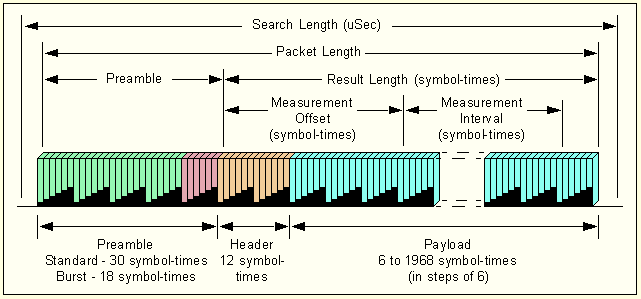Lengths, Intervals, and Offsets (MB-OFDM)
Menu Path: tab
This topic describes the relationships between , Result Length, , and . It is the and parameters that define a specific interval within the Result Length for demodulation and analysis, where the pulse appears within the search time of the . These parameters allow quick analysis and viewing of specific time intervals of data because the VSA does not acquire new measurement data when the or is changed. When a new or is entered, the VSA re-computes the trace data results using the existing measurement data.
- Search Length: specifies the length of time to acquire the input signal, which defines the length of time that the pulse search is performed. When this value is changed, the VSA must be restarted ().
- Result Length: Result Length displays the total number of symbol-times included in the acquired and demodulated data. This is the value that determines the packet length for the packet traces.
- Measurement Interval: determines what portion of the Result Length data is demodulated for the demodulation trace results.
- Measurement Offset: sets the start position of the Measurement Interval within the Result Length.
- PayLoad Octets: displays the resulting payload, in octets, for the Result Length and Data Rate settings.
The following illustration displays the interrelationship between the parameters Result Length, and PayLoad . The Preamble plus the Result Length form the Packet Length, which is used for the Packet Time and Packet Spectrum traces. For more information, see MB-OFDM Packet.

See Also
PayLoad Octet Calculations (MB-OFDM)
Using Standard Setups/Presets (MB-OFDM)
Format Tab (MB-OFDM Demod Properties)
Time Tab (MB-OFDM Demod Properties)
Advanced Tab (MB-OFDM Demod Properties)
